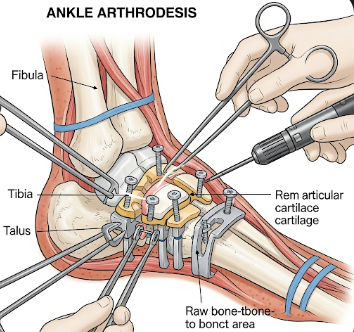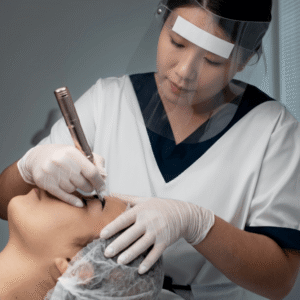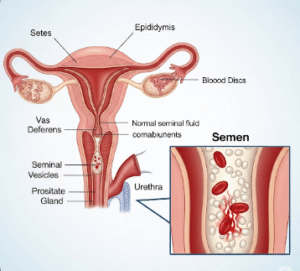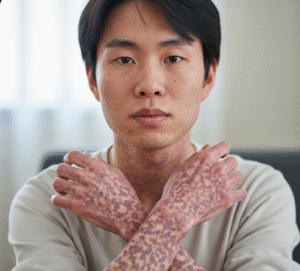Overview
Ankle arthrodesis, also known as ankle fusion, is a surgical procedure designed to fuse the bones of the ankle joint. It is primarily used to relieve severe pain, correct deformities, and stabilize the ankle in cases of advanced arthritis, trauma, or failed previous ankle surgeries.
In Korea, ankle arthrodesis is performed in highly advanced orthopedic centers by expert foot and ankle surgeons. Hospitals utilize state-of-the-art operating theaters, precision fixation devices, and advanced imaging, ensuring optimal bone fusion, minimal complications, and improved functional outcomes. Postoperative rehabilitation programs help patients regain mobility and adapt to lifestyle changes.
What is Ankle Arthrodesis?
Ankle arthrodesis involves surgically fusing the tibia (shinbone) and talus (ankle bone) to eliminate movement in the ankle joint, thereby reducing pain caused by joint degeneration.
Key points:
- Typically used for severe osteoarthritis, post-traumatic arthritis, or ankle deformities
- Can be performed using internal fixation (screws, plates) or external fixation
- Fusion stabilizes the joint, reduces pain, and improves weight-bearing capacity
- Although ankle motion is sacrificed, patients generally experience improved overall function and walking ability
What are the benefits?
- Effective pain relief for severe ankle arthritis or deformity
- Stabilizes the ankle joint, improving walking and balance
- Corrects deformities caused by injury, arthritis, or congenital conditions
- ✅ Allows patients to perform daily activities with reduced discomfort
- ✅ Can be combined with bone grafts or corrective procedures for optimal alignment
- ✅ In Korea, surgeons use modern fixation techniques and precise alignment strategies to ensure high success rates
Procedure Details
1) How should I prepare for Ankle Arthrodesis?
- ➤ Preoperative evaluation: Imaging (X-ray, CT, MRI), blood tests, and physical examination
- ➤ Discuss medications, especially blood thinners or anti-inflammatory drugs
- ➤ Fasting instructions prior to surgery if general anesthesia is planned
- ➤ Pre-surgery counseling about procedure, risks, post-op care, and recovery timeline
- ➤ Arrange for mobility assistance, as weight-bearing will be restricted initially
2) What happens during the procedure Ankle Arthrodesis?
- ✅ Performed under general or regional anesthesia
- ✅ Incision is made over the ankle joint to access the tibia and talus
- ✅ Damaged cartilage is removed to prepare bone surfaces for fusion
- ✅ Bones are positioned in optimal alignment and fixed with:
- Screws
- Plates
- Rods or external fixation if necessary
- ✅ Bone grafts may be used to enhance fusion
- ✅ Procedure duration typically ranges from 1–3 hours, depending on complexity
3) What happens after Ankle Arthrodesis?
- ➤ Patient is monitored in recovery and hospital settings
- ➤ Immobilization is applied using a cast or splint
- ➤ Pain management and antibiotics are administered as needed
- ➤ Non-weight-bearing is maintained for 6–12 weeks depending on bone healing
- ➤ Gradual rehabilitation begins after confirmed bone fusion via X-rays or CT scans
- ➤ Full return to daily activities may take 3–6 months
Risks / Benefits
Potential Risks:
- ➤ Infection at the surgical site
- ➤ Non-union or delayed bone fusion
- ➤ Nerve or blood vessel injury
- ➤ Pain in adjacent joints due to altered biomechanics
- ➤ Swelling, stiffness, or limited range of motion
Benefits:
- ✅ Significant pain relief in the affected ankle
- ✅ Stabilizes the joint, allowing improved walking and weight-bearing
- ✅ Corrects deformities and prevents further deterioration
- ✅ High long-term success rates when performed with advanced surgical techniques
- ✅ In Korea, expert surgeons minimize complications and ensure optimal alignment and fusion
Recovery and Outlook
- Hospital stay: Usually 2–5 days depending on procedure complexity
- Activity: Non-weight-bearing initially, with gradual transition to partial and full weight-bearing
- Rehabilitation: Physical therapy focuses on strength, balance, and mobility
- Full recovery: Typically 3–6 months, with confirmed bone fusion via imaging
- Lifestyle: Avoid high-impact activities early, maintain healthy weight, and use supportive footwear
When To Call the Doctor
- ➤ Signs of infection: redness, swelling, warmth, or discharge at the incision site
- ➤ Persistent or severe pain not controlled by medication
- ➤ Numbness, tingling, or unusual sensations in the foot or ankle
- ➤ Difficulty with weight-bearing or mobility beyond expected recovery
- ➤ Fever or systemic signs of infection
Best Korea Option / Process
- ✅ Korea offers specialized orthopedic centers for foot and ankle surgery
- ✅ Hospitals use advanced fixation devices, imaging technology, and experienced surgical teams
- ✅ Post-operative care includes immobilization, monitoring for complications, and guided rehabilitation
- ✅ International patients benefit from VIP services, English-speaking staff, and coordinated care
- ✅ High success rates and modern surgical techniques make Korea a preferred destination for ankle arthrodesis













